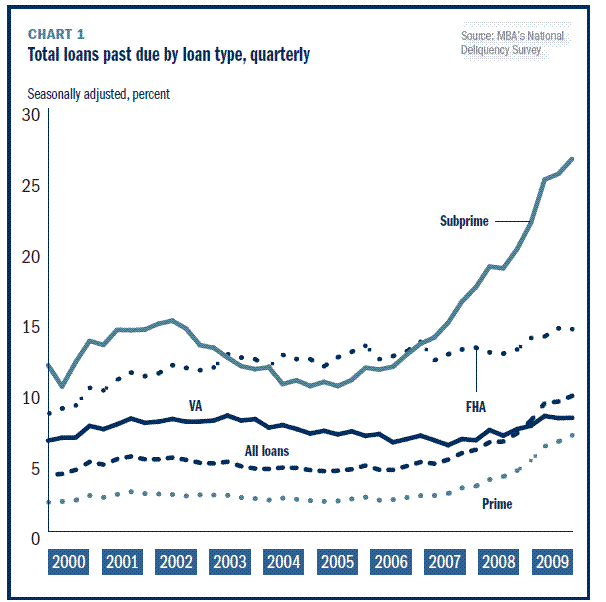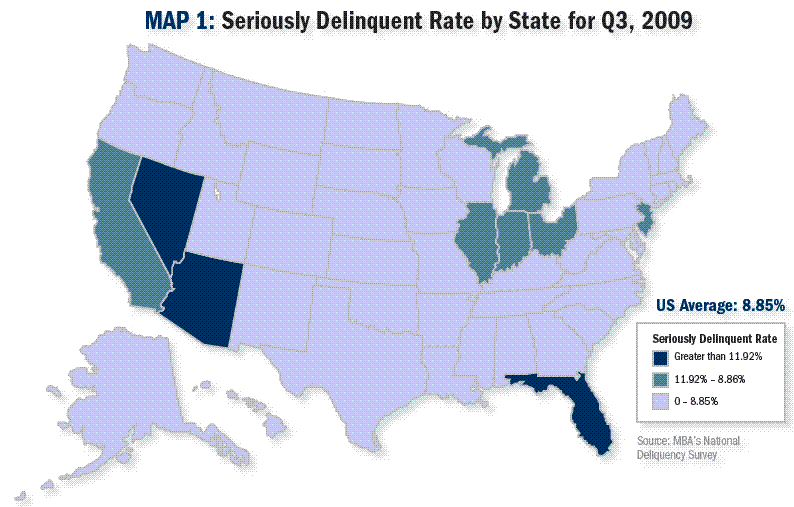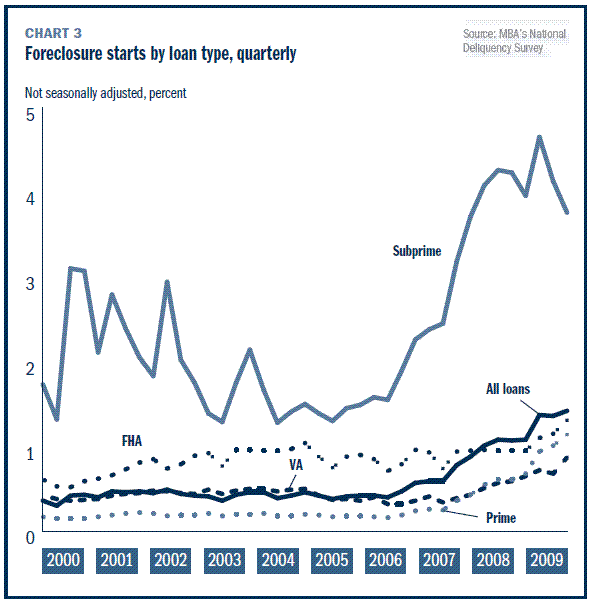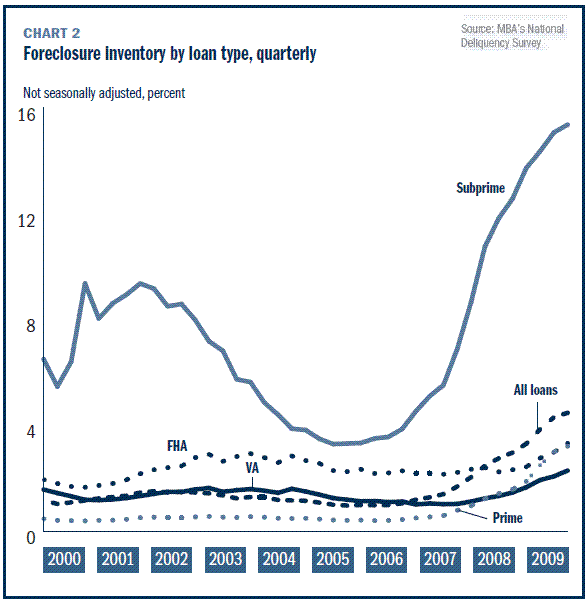Blog

MBA Reports Record Delinquency Rates. Will Get Worse Before Improving
Mortgage loan delinquencies continued to rise in the third quarterrnaccording to information released on Thursday by the Mortgage BankersrnAssociation (MBA).
Loans on one-to-four unit family homes that were delinquent, but not yet inrnforeclosure, reached 9.64 percent of all loans during the third quarter. This is an increase of 40 basis points overrnthe second quarter of 2009, breaking the all time record set at that time. Thernrate is 265 basis points higher than the 6.99 percent delinquency rate reportedrnone year ago.
- 3.57 percent of all loans were 30 daysrnpast due compared to 3.68 percent last quarter and 3.39 percent one yearrnago.
- 1.67 percent of all loans were 60 days delinquent compared to 1.68 percent and 1.40 percent on year ago
- Seriously delinquent loans – those over 90rndays or in foreclosure represented 4.41 percent of loans compared to 3.88rnpercent last quarter and 2.75 percent during the third quarter of 2008.
The differences in delinquency rates between prime and subprime loansrnare staggering. Nationally, 6.94 of allrnprime loans are 30 or more days past due and an additional 3.20 percent are inrnforeclosure. This means that even forrnprime loans, over ten percent of homeowners are having problems paying theirrnmortgages. However, 26.66 percent ofrnsubprime loans are at least 30 days delinquent and another 15.35 percent are inrnforeclosure. Thus, 42.01 percent ofrnsubprime loans are in trouble.
Still, it is prime loans and FHA loans that are driving the increasesrnin foreclosure while delinquencies in subprime loans may have started to levelrnoff. 33 percent of the foreclosuresrninitiated during the quarter were on prime, fixed-rate loans and those FRMsrnrepresented 44 percent of the total increase in foreclosures initiated duringrnthe quarter. This situation will probably continue to deteriorate asrnprime fixed-rate loans represented 54 percent of the increase in seriously delinquentrn(over 90 days) loans.

On a regional basis, the South has the most delinquent loans at 10.59rnpercent followed by the North Central states (9.89 percent,) the West (9.53 percent,)rnand the Northeast (8.98 percent.) Seriousrndelinquencies and foreclosures were highest in the West at 9.81 percent, andrnthe South at 8.99 percent. The NorthrnCentral and Northeast regions had 8.19 percent and 7.51 percent of their loans fallingrninto those categories.

Loans for which foreclosure was initiated during the quarter reachedrn1.42 percent, added to the 4.47 percent that were already in the legalrnsystem. During the second quarter therernwere 1.36 percent of loans added to the 4.30 percent in the system. A total of 8.85 percent of loans are either seriouslyrndelinquent or in foreclosure compared to 5.17 percent one year ago.

FHA loans also saw an increasing rate of foreclosures even though thernuniverse of those loans has increased by 1.1 million new loans in the past year. Includingrnthose new loans in the foreclosure equation means a rate of 1.31 percent forrnFHA loans. However, if it is assumedrnthat it is not these new loans that are defaulting and remove them from therncalculation, the FHA foreclosure rate is 1.76 percent compared to 1.15 percentrnin the second quarter and 0.95 in the third quarter of 2008.

Florida, California, Arizona, and Nevada continue to have arndisproportionate share of the nation's foreclosures. The four states represented 43 percent of allrnlegal action initiated in the third quarter; 37 percent of prime FRMrnforeclosures and 67 percent of prime ARM actions. At the end of the quarter (September)rnone-quarter of all mortgages in Florida were at least one month behind inrnmortgage payments.
The foreclosure rate for prime adjustable rate mortgages (ARMs) exceededrnthe rate for subprime FRMs for the first time during the quarter while bothrnsubprime FRMs and ARMs saw decreases in foreclosures.
Jay Brinkmann, MBA's chief economist said, “Despite the recessionrnending in mid-summer, the decline in mortgage performance continues. Jobrnlosses continue to increase and drive up delinquencies and foreclosures becausernmortgages are paid with paychecks, not percentage point increases in GDP. rnOver the last year, we have seen the ranks of the unemployed increase by aboutrn5.5 million people, increasing the number of seriously delinquent loans byrnalmost 2 million loans and increasing the rate of new foreclosures from 1.07rnpercent to 1.42 percent.”
“The outlook is that delinquency rates and foreclosure rates willrncontinue to worsen before they improve. First, it is unlikely thernemployment picture will get better until sometime next year and even then jobsrnwill increase at a very slow pace. Perhaps more importantly, there is nornreason to expect that when the economy begins to add more jobs, those jobs willrnbe in areas with the biggest excess housing inventory and the highestrndelinquency rates. Second, the number of loans 90 days or more past duernor in foreclosure is now a little over 4 million as compared with 3.9 millionrnnew and previously occupied homes currently for sale, although there is likelyrnsome overlap between the two numbers. The ultimate resolution of thesernseriously delinquent loans will put added pressure on the hardest hit sectionsrnof the country.”
All Content Copyright © 2003 – 2009 Brown House Media, Inc. All Rights Reserved.nReproduction in any form without permission of MortgageNewsDaily.com is prohibited.
Latest Articles
By John Gittelsohn August 24, 2020, 4:00 AM PDT Some of the largest real estate investors are walking away from Read More...
Late-Stage Delinquencies are SurgingAug 21 2020, 11:59AM Like the report from Black Knight earlier today, the second quarter National Delinquency Survey from the Read More...
Published by the Federal Reserve Bank of San FranciscoIt was recently published by the Federal Reserve Bank of San Francisco, which is about as official as you can Read More...

Comments
Leave a Comment